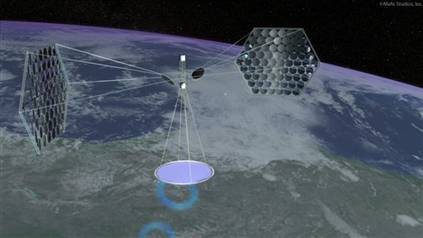 It may sound like the stuff of science fiction, but at the same time it could also be the method whereby solar power could be magnified to a global industrial scale.
It may sound like the stuff of science fiction, but at the same time it could also be the method whereby solar power could be magnified to a global industrial scale.
According to former NASA manager of Advanced Concepts Studies Office of Space Flight , John C. Mankins, space-based solar power (SSP) systems could be capable of meeting the energy needs of millions of people. What’s more, it could be “deployed within a decade using technologies that are today in the laboratoryâ€, he told the World Future Society. Mr. Mankins is one of the world’s leading experts on space-based solar power.
Mankins was speaking last week at the National Press Club in Washington, D.C., where he described the findings of a new report on space solar power. So far experts have considered space solar power too expensive to become a reality since it requires sending to space satellites that collect solar light. But Mankins begs to differ.
The space solar power expert said that it is possible to have multi-megawatt transmissions at $1 to $5 per kilowatt hour in the near future (10 to 15 years). The satellites beam energy to Earth using microwaves. The energy is collected via rectnennas composed of a simple mesh. Mankins says the solar energy transferred to Earth and the mesh would have no impact on the environment and animal health.
But why pursue such a complex method of tapping solar power? Supporters say it solves two of the current setbacks associated with terrestrial solar: efficiency and reliability. Solar power collection is estimated to be 10 times more efficient than on Earth and it is never interrupted by clouds and other meteorological conditions. The study also projects the creation of millions of jobs for people who would build and launch the satellites.
Space solar power is not conceived as a replacement for terrestrial solar power, though. Instead, both types of solar power collection would complement each other.
Follow the link to read more details about space solar power.
What do you think? Is space solar power a viable solution to our energy needs?
You should follow us here.





